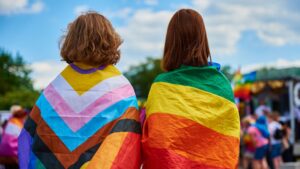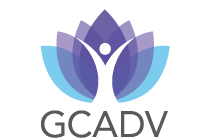By: Sarah Brown – Director of Communications

LGBTQIA+ people face an array of stigma and discrimination that undermines their ability to have stable, safe, and affordable housing, and still federal, state, and local laws provide only a patchwork of protections against anti-LGBTQIA+ discrimination in housing, lending, and social services. During the time of the COVID-19 pandemic, we saw people living in poverty along with the loss of work lead to major housing instability and homelessness.
Atlanta’s lack of affordable housing and booming gentrification are serious problems for all low-income people in our city – but some communities are hit harder than others. The Atlanta Volunteer Lawyers Foundation says:
“As advocates for housing justice, it’s critical for us to recognize this and understand the reasons why”.
LGBTQIA+people are disproportionately living in poverty, and therefore are more likely to need affordable housing.
A recent study by the Williams Institute at UCLA School of Law found that 21.6% of LGBTQIA+ people in the United States experience poverty, compared to 15.7% of cisgender* straight people. The study found that one in five (21%) LGBTQIA+ people in urban areas live in poverty, and one in four (26.1%) in rural areas are poor, compared to about 16% of cisgender straight people in both areas.
LGBTQIA+ people are less likely to have family safety nets to turn to in times of need.
Countless times, our clients have told us that they turn to family members when they lose their housing. Sometimes this looks like moving into a brother’s guest bedroom or sleeping on a mother’s couch. Sometimes it looks like emergency loans from cousins or grandmothers. In the absence of an effective governmental or charitable safety net, family often fills in the gaps.
This link will show you the fair housing Act for Georgia: https://www.dca.ga.gov/newsroom/blog/who-covered-fair-housing-act-georgia-fair-housing-law.
Georgia Law states under What is Prohibited “Discrimination in housing includes activities such as refusing to rent or sell to someone, charging different rates, or offering different terms based on these characteristics. It could also include making discriminatory statements or disseminating discriminatory advertising. It also prohibits making false statements about the availability of housing to members of a protected class”.
This link is to Georgia Community Affairs. https://www.dca.ga.gov/node/1781.
While this is written very well, we know that this happens, however, it is not easy to prove.
I can remember, a time ago when me and my partner went to look at a one-bedroom apartment, and the landlord asked us if we were sisters and we said no, then he said to us you do know that this is a one-bedroom apartment so where will the other person sleep. Needless to say, he did not rent the apartment to us, and although we couldn’t prove that this was blatant discrimination, we knew it was.
Housing affordability: LGBTQIA+ people are 15% LGBTQIA+ adults have at least 15% higher odds of being poor than cisgender straight adults after controlling for age, race, urbanicity, employment status, language, education, disability, and other factors that affect risk of poverty
Among LGBTQIA+ people, poverty is especially prevalent among racial minorities, bisexuals, women, transgender people, and younger people
(e.g., Badgett, 2018; Badgett et al., 2019; Carpenter et al., 2020; Meyer et al., 2019).
Homeownership: according to representative data from 35 states, nearly half (49.8%) of LGBTQIA+ adults own their homes, compared to 70.1% of non-LGBT adults. Homeownership is even lower among LGBTQIA+ racial minorities and transgender people
Homeownership is higher among married couples than unmarried couples, but married same-sex couples significantly are less likely to own their homes than married different-sex couples 72% and 79.4%, respectively. Same-sex couples are significantly less likely to own their homes than different-sex couples (63.8% and 75.1%, respectively) (original analyses herein).
(Conron et al., 2018; Meyer et al., 2019).
Discrimination: LGBTQIA+people face widespread harassment and discrimination by housing providers, who, for example, studies have shown are less likely to respond to rental inquiries from same-sex couples (Friedman et al., 2013) and are more likely to quote male same-sex couples higher rents (Levy et al., 2017) than comparable different-sex couples.
LGBTQIA+ elders are at risk of being turned away from or charged higher rents at independent or assisted living centers (Equal Rights Center, 2014), as well as harassed, treated poorly, or forced to go back in the closet once moved in (e.g., AARP Research, 2018).
Same-sex couples face system-wide discrimination by mortgage lenders, with one study finding that, compared to different-sex borrowers of similar profiles, same-sex borrowers experienced a 3% to 8% lower approval rate and, among approved loans, higher interest and/or fees (Sun & Gao, 2019).
Discrimination against LGBTQIA+ people in employment and other settings is widespread and can destabilize housing and make it more unaffordable.
LGBTQIA+ people may face not only sexual orientation or gender identity discrimination in housing but also other forms of disadvantage, such as racial prejudice, language barriers, and inaccessibility related to a disability.
What can we do:
- Adoption and enforcement of comprehensive federal and state protections against sexual orientation and gender identity discrimination in housing, lending, and government-funded programs and activities, among other settings.
- Evaluation of the extent to which LGBTQIA+ people face barriers to accessing programs and services aimed at increasing housing affordability and reducing housing instability—such as Section 8 and home buying programs of the Federal Housing Administration—and execution of corrective actions as necessary.
- Allocation of governmental and private funding to develop and implement evidence-based programs to reduce stigma and discrimination faced by LGBTQIA+ youth and adults, including within LGBTQIA.. people’s families-of-origin.
- Expansion of housing and shelter options for LGBTQIA+ youth and adults so that they are sheltered safely and appropriately.
- Mandated training for all staff at agencies providing housing, child welfare, homelessness, and other relevant services to the LGBTQIA+ population, in order to ensure that staff become and remain equipped to serve LGBTQIA+ people in an affirming manner.
- Enhanced data collection and research on housing issues faced by the LGBTQIA+ population and subpopulations to improve our knowledge base and help design interventions.
